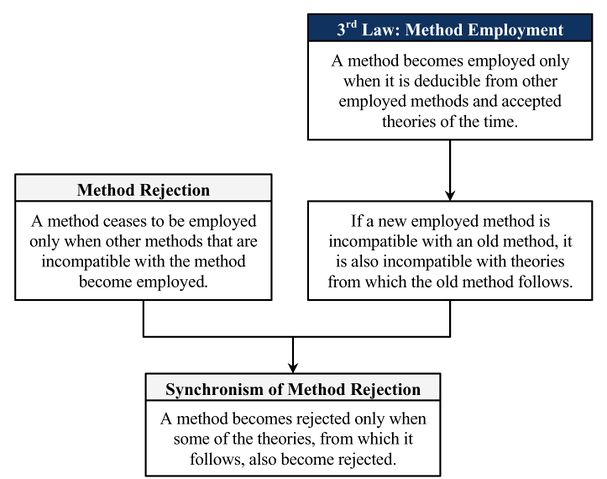Difference between revisions of "Synchronism of Method Rejection theorem (Barseghyan-2015) Reason1"
Izzy Friesen (talk | contribs) m |
|||
| Line 3: | Line 3: | ||
|Title=Synchronism of Method Rejection Deduction | |Title=Synchronism of Method Rejection Deduction | ||
|Premises=Method Rejection theorem (Barseghyan-2015), The Third Law (Barseghyan-2015) | |Premises=Method Rejection theorem (Barseghyan-2015), The Third Law (Barseghyan-2015) | ||
| + | |Formulation Text=The ''synchronism of method rejection'' theorem is a deductive consequence of the method rejection theorem and the third law. | ||
|Diagram File=Synchronism-of-method-rejection.jpg | |Diagram File=Synchronism-of-method-rejection.jpg | ||
|Authors List=Hakob Barseghyan | |Authors List=Hakob Barseghyan | ||
|Formulated Year=2015 | |Formulated Year=2015 | ||
| − | |Description=Barseghyan explains the deduction: | + | |Description=Barseghyan explains the deduction:[[CiteRef::Barseghyan (2015)|pp. 177-178]] |
| − | + | ||
| + | <blockquote> | ||
| + | By the ''method rejection theorem'', a method is rejected only when other methods incompatible with the method become employed. Thus, we must find out when exactly two methods can be in conflict. In order to find that out, we must refer to the ''third law'' which stipulates that an employed method is a deductive consequence of accepted theories and other methods. Logic tells us that when a new employed method is incompatible with an old method, it is also necessarily incompatible with some of the theories from which the old method follows. Therefore, an old method can be rejected only when some of the theories from which it follows are also rejected.<blockquote> | ||
| + | |||
| + | {{PrintDiagramFile|diagram file=Synchronism-of-method-rejection.jpg}} | ||
|Resource=Barseghyan (2015) | |Resource=Barseghyan (2015) | ||
| + | |Page Status=Stub | ||
| + | |Editor Notes= | ||
}} | }} | ||
Revision as of 10:50, 17 January 2024
Barseghyan explains the deduction:1pp. 177-178
By the method rejection theorem, a method is rejected only when other methods incompatible with the method become employed. Thus, we must find out when exactly two methods can be in conflict. In order to find that out, we must refer to the third law which stipulates that an employed method is a deductive consequence of accepted theories and other methods. Logic tells us that when a new employed method is incompatible with an old method, it is also necessarily incompatible with some of the theories from which the old method follows. Therefore, an old method can be rejected only when some of the theories from which it follows are also rejected.
This reason for Synchronism of Method Rejection theorem (Barseghyan-2015) was formulated by Hakob Barseghyan in 2015.1
